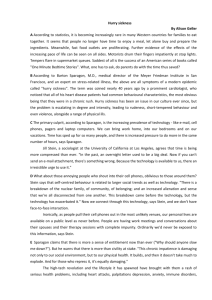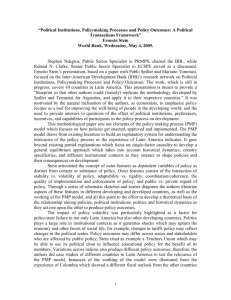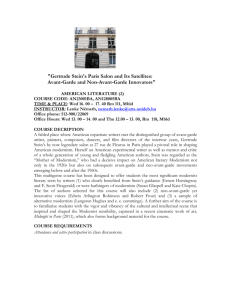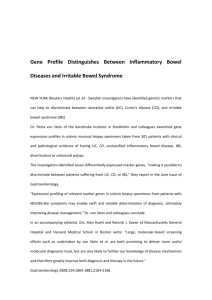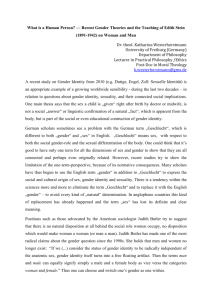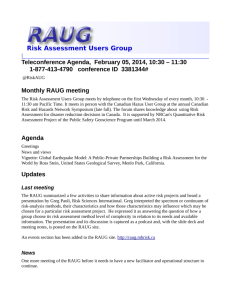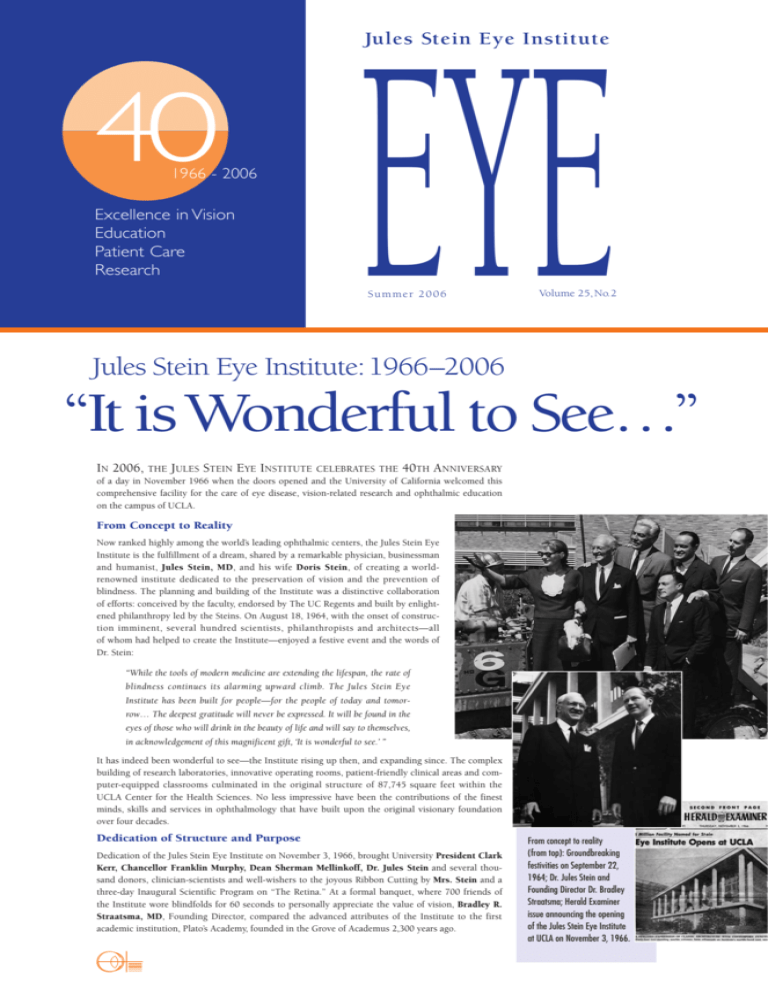
Jules Stein Eye Institute
40
1966 - 2006
Excellence in Vision
Education
Patient Care
Research
EYE
Summer 2006
Volume 25, No.2
Jules Stein Eye Institute:1966–2006
“It is Wonderful to See…”
IN 2006, THE JULES STEIN EYE INSTITUTE CELEBRATES THE 40TH ANNIVERSARY
of a day in November 1966 when the doors opened and the University of California welcomed this
comprehensive facility for the care of eye disease, vision-related research and ophthalmic education
on the campus of UCLA.
From Concept to Reality
Now ranked highly among the world’s leading ophthalmic centers, the Jules Stein Eye
Institute is the fulfillment of a dream, shared by a remarkable physician, businessman
and humanist, Jules Stein, MD, and his wife Doris Stein, of creating a worldrenowned institute dedicated to the preservation of vision and the prevention of
blindness. The planning and building of the Institute was a distinctive collaboration
of efforts: conceived by the faculty, endorsed by The UC Regents and built by enlightened philanthropy led by the Steins. On August 18, 1964, with the onset of construction imminent, several hundred scientists, philanthropists and architects—all
of whom had helped to create the Institute—enjoyed a festive event and the words of
Dr. Stein:
“While the tools of modern medicine are extending the lifespan, the rate of
blindness continues its alarming upward climb. The Jules Stein Eye
Institute has been built for people—for the people of today and tomorrow… The deepest gratitude will never be expressed. It will be found in the
eyes of those who will drink in the beauty of life and will say to themselves,
in acknowledgement of this magnificent gift, ‘It is wonderful to see.’ ”
It has indeed been wonderful to see—the Institute rising up then, and expanding since. The complex
building of research laboratories, innovative operating rooms, patient-friendly clinical areas and computer-equipped classrooms culminated in the original structure of 87,745 square feet within the
UCLA Center for the Health Sciences. No less impressive have been the contributions of the finest
minds, skills and services in ophthalmology that have built upon the original visionary foundation
over four decades.
Dedication of Structure and Purpose
Dedication of the Jules Stein Eye Institute on November 3, 1966, brought University President Clark
Kerr, Chancellor Franklin Murphy, Dean Sherman Mellinkoff, Dr. Jules Stein and several thousand donors, clinician-scientists and well-wishers to the joyous Ribbon Cutting by Mrs. Stein and a
three-day Inaugural Scientific Program on “The Retina.” At a formal banquet, where 700 friends of
the Institute wore blindfolds for 60 seconds to personally appreciate the value of vision, Bradley R.
Straatsma, MD, Founding Director, compared the advanced attributes of the Institute to the first
academic institution, Plato’s Academy, founded in the Grove of Academus 2,300 years ago.
From concept to reality
(from top): Groundbreaking
festivities on September 22,
1964; Dr. Jules Stein and
Founding Director Dr. Bradley
Straatsma; Herald Examiner
issue announcing the opening
of the Jules Stein Eye Institute
at UCLA on November 3, 1966.
“It is Wonderful to See...”
continued
scholarly journals, and as members of various government and
private foundation scientific advisory panels.
Facilities
Clinical areas, laboratories, operating rooms, core equipment and
all other facilities of the Institute were purposefully planned to
merge comfort and grace with state-of-the-art resources for patient
care, research and education. In the years after 1966, burgeoning
programs rapidly filled the Institute’s once-ample space. In particular, emerging areas of basic science such as visual biochemistry,
neurophysiology and genetics prompted the carving out of another 20,000 square feet from a contiguous parking structure for
vision research laboratories, newer equipment and a computerized
library-learning center.
“The physical difference between the first academic
institution, an olive grove, and the most recent, the
Four decades of key people and partners
(clockwise from top): The JSEI Founding
Board of Trustees; Dr. Jules Stein with Lew
Wasserman; UCLA ophthalmology leaders:
Drs. S. Rodman Irvine (Acting Chief
1955–1958, center), Bradley Straatsma
(Chief and Chairman 1959–1993, right)
and Bartly Mondino (Chairman 1994–
Present, left)
Jules Stein Eye Institute, is enormous. However, the
difference in principle and purpose is nonexistent. Both
were founded primarily by private citizens who recognized a need. Both were staffed by academicians
endowed with the ability to ask questions, to pose
problems and to search for answers. The challenge is
still at the boundary of existing knowledge.”
The dedication of the structure was matched by dedication of
purpose and, over the past 40 years, the Jules Stein Eye Institute
has been pushing the boundaries of knowledge by sustaining a
continuum of exciting developments that have made the most of
its tremendous resources of people, facilities and programs.
Partnering for Success
EYE
N EWSLETTER
IS A PUBLICATION
OF THE
JULES STEIN EYE INSTITUTE
DIRECTOR
Bartly J. Mondino, MD
EDITORS
Debora B. Farber, PhD, DPhhc
Gary N. Holland, MD
MANAGING EDITOR
Gloria P. Jurisic
CONTRIBUTING EDITORS
Teresa Closson
Nancy Graydon
Sonia Jones
Debbie Sato
Lori Twitchell
Melania Vartanian
GUEST CONTRIBUTORS
Cherie Hubbell
Bradley R. Straatsma, MD, JD
Ruth Straatsma
PHOTOGRAPHY
J. Charles Martin
DESIGN
Robin Weisz /Graphic Design
PRODUCTION COORDINATION
Coniglio & Associates
by The Regents of the
University of California.
All rights reserved.
The University of California partnership with philanthropists
and community leaders, manifested by the construction of the
Institute on the UCLA campus, was formalized in 1977. That
agreement between Dr. Stein and The UC Regents established the
independent JSEI Board of Trustees, initially: Judge W. Matthew
Byrne, Jr.; David May II; Chancellor Franklin D. Murphy;
Jules Stein, MD; and Bradley R. Straatsma, MD. Current
trustees: Robert Ahmanson; Bartly J. Mondino, MD; Ronald
Olson; Gerald Oppenheimer; Nelson C. Rising; George Smith;
Katrina vanden Heuvel and Casey Wasserman, continue this
important responsibility by regularly providing valuable oversight
and support.
www.jsei.org
The facility was linked to the Jules Stein building with a practical
colonnade, the architecturally unique Robert Adam Room and the
Research to Prevent Blindness Auditorium. In aggregate, the Jules
Stein Eye Institute in 2006 provides more than 175,000 square
feet of core facilities for ophthalmology and vision-related science.
Programs
From the beginning, whether in architectural configuration or
equipment, the form and facilities of the Institute have been based
upon three core missions: excellence in patient care, research and
education. The three areas are synergistically effective, each contributing to and benefiting from the others, earning the Jules Stein
Eye Institute, in a comparatively short time, worldwide respect as
a leader and innovator in the field of ophthalmology and the
vision sciences.
P AT I E N T C A R E
The Institute “…has been built for people,” as Dr. Stein proclaimed, and several million ophthalmic patient examinations
and procedures have been performed at the Institute and UCLAaffiliated programs over the past four decades.
Each year, services to patients at the Jules Stein Eye Institute on
UCLA’s Westwood Campus include more than 100,000 annual
patient visits, ophthalmic laboratory tests and surgical procedures.
Faculty and staff—research scientists, clinician-scientists and
specialists of outstanding quality—responsible for the Institute’s
programs and services have grown in numbers as well as the range
of disciplines they integrate. From its founding, with Dr.
Straatsma as Director (1964–1993) and 11 faculty members:
Raymond Allen, MD; Leonard Apt, MD; Robert Christensen,
MD; Fredrick Crescitelli, PhD; Michael Hall, PhD; Joram
Heller, MD; S. Rodman Irvine, MD; Thomas Pettit, MD; Niles
Roth, PhD; Bradley Straatsma, MD; and Richard Young, PhD;
the Institute has grown to comprise some 33 Members, nine
Associate Members and 17 Consulting Members led by Director
Dr. Mondino (1994–present).
Corresponding growth has occurred in the volunteer faculty,
now 213, who hold Clinical Faculty appointments in the UCLA
Department of Ophthalmology and serve as teachers and clinical
specialists in the Institute’s education and training programs.
©2006,
Jules Stein Eye Institute
100 Stein Plaza, UCLA
Box 957000
Los Angeles, CA 90095–7000
(310) 206-6035
The crowning event in Institute expansion was the dedication of
the Doris Stein Eye Research Center on September 21, 1989. After
her husband’s death in 1981 and before her own in 1984, Mrs.
Stein acted on the need for expanded facilities by continuing
the Stein family legacy. Institute trustees, led by Mr. Lew R.
Wasserman, The UC Regents and Institute faculty embarked on a
design-build project that resulted in the architecturally compatible
Doris Stein Eye Research Center. It provided more than 67,000
square feet for clinical research and patient care areas, the Clinical
Research Center, an Ophthalmology Imaging Center and basic
laboratories for translational research.
The individual and combined accomplishments of Institute faculty have garnered national and worldwide honors: election to the
National Academy of Sciences, the American Academy of Arts
and Sciences and the Ophthalmology Hall of Fame. Full-time and
volunteer clinical faculty have also brought recognition to the
Institute as they serve on the National Advisory Eye Council, as
elected officers of ophthalmic professional societies, as editors of
The many faces of patient care
(clockwise from top): The
Institute’s trauma team
performs a series of surgeries
on a child whose eyes had been
severely injured during the war
in Bosnia; JSEI is recognized for
its advanced surgical expertise;
the Institute extends eye care
to the underserved through the
UCLA Mobile Eye Clinic
Extending beyond the walls of the Institute are major ophthalmology patient care programs at Los Angeles County’s Harbor—
UCLA Medical Center and Olive View—UCLA Medical Center,
as well as the Veterans Affairs Greater Los Angeles Healthcare
System’s West Los Angeles Healthcare Center and Sepulveda
Medical Center. Further reaching out into the community are
affiliations with the King Drew Medical Center in Central Los
Angeles and the UCLA Mobile Eye Clinic.
The growth in numbers—patients, procedures and clinical programs—over the past 40 years has been matched by the tremendous advances in management of eye disease. These encompass
an enormous range of comprehensive and subspecialty interventions that reflect the growth in medical knowledge and technology of our era. In 1966, cataract surgery was an inpatient procedure followed by a hospital stay of several days and long-term use
of a thick eyeglass or contact lens. Today, it is an outpatient procedure with elective implantation of a multifocal intraocular lens.
The availability of lasers to control diabetic retinopathy and
correct vision, pharmaceutical therapies to manage age-related
macular degeneration and computerized models to plan strabismus surgery, are all examples of advances that have dramatically
changed the way we treat patients with eye disease in 2006.
RESEARCH
JSEI scientists are currently conducting dozens of basic laboratory
studies and more than 50 IRB-approved clinical trials of therapy
for eye disease. Examples of basic, translational and clinical
investigations include:
◆ Proteomics relating molecular structure of visual proteins to
conformational change that “switches” function and initiates
vision
◆ Genomics to determine DNA abnormalities responsible for
eye disease
◆ Treatment studies on a mouse model of the childhood blinding
disease Stargardt macular degeneration
◆ Translation of basic mechanisms for optic nerve disease to
measurement of optic nerve disease in glaucoma
◆ Clinical studies to evaluate cataract surgery-related multifocal
intraocular lenses
◆ Clinical trials of anti-angiogenesis agents as therapy for
age-related macular degeneration (AMD)
E D U C AT I O N
The third pillar of the Jules Stein Eye Institute’s programs—
education—is provided by the Institute and the Department of
Ophthalmology through a continuum of innovative and comprehensive programs for meeting degree and certificate requirements.
Education within the Institute since 1966 has involved thousands
of UCLA medical students, hundreds of ophthalmologists who
completed residency training, and additional hundreds of clinical
ophthalmology fellows, and pre- and postdoctoral vision science
fellows. Beyond these individuals are the incalculable number of
ophthalmologists and research scientists who have participated in
Institute programs of continuing professional development.
As with the Institute’s other programs, those relating to education
have grown not only in numbers, but also in their comprehensiveness and range. The ophthalmology program for UCLA
medical student education, an eight to 12-hour Fundamentals
of Clinical Medicine course in the 1960s, is today a phased, fouryear curriculum. The ophthalmology residency program, ranked
among the best in the country, now incorporates the EyeSTAR
(Specialty Training and Advanced Research) Program leading to a
PhD degree or equivalent expertise for those interested in academic careers and professional leadership as clinician-scientists.
Advancing scientific discovery (clockwise from top): The Clinical Research
Center (CRC) dedicated in 1998, pictured CRC Director Dr. Gary Holland
(right) and JSEI Director Dr. Bartly Mondino (left); a seminal discovery in
the 1960s by JSEI vision scientists, Drs. Richard Young and Dean Bok,
shows renewal of the light-sensitive outer segments in retinal photoreceptor
cells; JSEI vision scientist Dr. Wayne Hubbell elected to the National
Academy of Sciences on May 3, 2005
Driving the patient care and education programs at the Institute
is the continuing leadership of its faculty in vision science and
clinical research. From the seminal discovery of retinal photoreceptor renewal in the 1960s, to the development of mouse models
of human retinal degeneration, and new technology for studying
protein dynamics and function, the Institute’s vision scientists
have been pioneers in emerging fields such as genetics and
biophysics, providing insight into pathogenic mechanisms of
vision-threatening diseases.
Bridging its basic research mission and patient care mission are
the Institute’s clinical studies. Over the years, faculty have participated in key clinical investigations—the first report of the ocular
manifestations of AIDS in the 1980s, pivotal studies of diabetic
retinopathy, the nationwide Collaborative Ocular Melanoma
Study, and discovery and characterization of the role of extraocular pulleys in eye muscle disease, to name a few. These have made
emerging therapies available to patients and led to improved
management of various ophthalmic problems.
The continuum of education at the Institute, including a broad
range of advanced training programs for doctoral, postdoctoral
and specialty research fellows, as well as ophthalmologists from
here and abroad, extends the reach of the Institute’s clinical and
research excellence throughout the world and into the future.
Educating tomorrow’s leaders (clockwise
from top): Pre- and postdoctoral fellows
benefit from the Institute’s vision science
programs; physicians receive supervised
clinical experience in JSEI’s nationally
recognized residency program;
continuing education programs offer
opportunities for practicing ophthalmologists to further their professional
development
Looking Ahead
Never in history has medicine been more exciting or infused with
greater promise of benefits. The confluence of molecular biology,
medical technology and supercomputer-informatics creates
unprecedented opportunities for physicians to enhance the quality of life for patients. The pace of progress is accelerating and
UCLA’s Jules Stein Eye Institute, on its 40th anniversary, is well
positioned for the future with innovative programs of education
for tomorrow’s leaders, a faculty committed to the full spectrum
of basic and clinical research, and an outreach of ophthalmic
services to all sectors of Greater Los Angeles.
“The celebration of the 40th Anniversary gives me the
opportunity to thank each and every faculty and staff
member for the hard work and dedication, and to
thank our community of friends whose commitment
and financial support over these four decades have
contributed to the success of the Jules Stein Eye
Institute. As we look to the future, plans for an additional facility and breakthroughs in clinical and laboratory research promise to elevate the Institute to a
higher level of achievement in eradicating blindness
and preserving vision, and to fulfill Dr. Stein’s dream
A star on the horizon is the eagerly awaited construction (scheduled for 2007) of the Edie and Lew Wasserman Eye Research
Center. Named to honor Edie Wasserman and the late Lew
Wasserman, generous benefactors and friends of JSEI, the
100,000 square foot facility will be situated opposite to the Doris
Stein Eye Research Center and form the northern cornerstone of
the Institute’s vision science plaza. With facilities for advanced
eye surgery and gene therapy, vision science research, and synergistic programs relating JSEI to other departments within the
David Geffen School of Medicine at UCLA, the Wasserman
Center will enable faculty to create revolutionary new initiatives
that will dramatically change the way we diagnose, treat, cure and
prevent eye disease.
for everyone to realize, ‘it is wonderful to see.’”
Artist’s rendering of the completed Jules
Stein Eye Institute campus: From left, the
Edie and Lew Wasserman Eye Research
Center (construction scheduled for 2007),
the Jules Stein Eye Institute building
(dedicated in 1966) and the Doris Stein
Eye Research Center (dedicated in 1989)
In just 40 years, the Institute’s comprehensive programs in patient
care, research and education, coupled with its state-of-the art
facilities, have brought national and international recognition to
the Institute and UCLA. Dr. Mondino expresses appreciation for
the generous support extended to the Institute by the Stein family
and many other contributors and pride in its outstanding faculty
and staff:
EYE LINES
UCLA Department of Ophthalmology Association
UCLA Department of
Ophthalmology Association
T H E UCLA D E PA RT M E N T O F
O P H T H A L M O L O G Y A S S O C I AT I O N
HISTORY OF OFFICERS
Current Officers, 2004–2006
Robert A. Clark, MD, President
Kathryn M. Gardner,. MD, Vice-President
Robert A. Goldberg, MD, Secretary/Treasurer
T
he UCLA Department of Ophthalmology Association was
established in 1974 to encourage professional interaction
among its members, to support the academic programs of the
Department of Ophthalmology and the Jules Stein Eye Institute,
and to promote the advancement of ophthalmic science.
Past Presidents
The Association includes all members of the faculty of the
UCLA Department of Ophthalmology, current and former
residents and fellows of the Department of Ophthalmology
programs, as well as honorary members. Annual Association
dues support:
◆ the annual Research Grant Awards for JSEI Residents
and Fellows
◆ the JSEI Clinical and Research Seminar that takes places
each spring
◆ the Video Library Project
◆ the Alumni Reception at the Annual AAO Meeting
◆ other important alumni networking events
Association membership has grown exponentially over the
years, boasting a current membership of more than 600 alumni
dating back to the opening of the Institute in 1966. Located in
26 different countries throughout the world, JSEI residents and
fellows have had a global impact in the field of ophthalmology.
Most of the international fellows who train at the Jules Stein Eye
Institute return to their country of origin to practice and teach
others. Several have gone on to become leaders in their field and
directors of Departments where they practice and teach.
First graduating class (inclusive of faculty) on the steps of the newly
constructed Jules Stein Eye Institute, Class of 1967—First row (left to right):
Drs. Harold B. Alexander, Thomas H. Pettit, Robert E. Christensen, Bradley R.
Straatsma, Robert E. Bartlett; Second row: Drs. Leland M. Garrison, Allan E.
Kreiger, Richard N. Learn, Maurice B. Landers, Knute Guldjord, Dennis D.
Shepard; Third row: Drs. Bruce J. Lenartz, Alan L. Susal, Harry S. Brown,
Phillip N. Hale, George B. Miller, John R. Hushaw; Fourth row: Drs. Stephen N.
Hull, Kenneth L. Westbrook, James P. McDonald, John D. Slaney. Not shown
are faculty members Drs. Leonard Apt and Robert S. Hepler.
Peter J. Cornell, MD, 2002–2004
Norman Shorr, MD, 2000–2002
Lynn K. Gordon, MD, PhD, 1999–2000
Norman Shorr, MD, 1998–1999
Stanley M. Kopelow, MD, 1997–1998
Alan L. Shabo, MD, 1996–1997
Barry M. Kerman, MD, 1995–1996
Howard R. Krauss, MD, 1994–1995
George M. Rajacich, MD, 1993–1994
Edwin P. Hill, MD, 1992–1993
James W. McKinzie, MD, 1991–1992
Stephen R. Seiff, MD, 1989–1991
Robert E. Bartlett, MD, 1988–1989
Sidney W. Penn, MD, 1987–1988
Gerald S. Sanders, MD, 1986–1987
Howard H. Stone, MD, 1985–1986
Donald E. Dickerson, MD, 1984–1985
Jack Fields, MD, 1983–1984
Richard Elander, MD, 1982–1983
David D. Michaels, MD, 1981–1982
Henry I. Baylis, MD, 1980–1981
C. Richard Hulquist, MD, 1979–1980
Roger W. Sorenson, MD, 1978–1979
Sherwin H. Sloan, MD, 1977–1978
George B. Primbs, MD, 1976–1977
Irvin S. Pilger, MD, 1975–1976
S. Rodman Irvine, MD, 1974–1975
C
o m m u n i t y
O
u t r e a c h
Four Decades of Reaching Out to the Community
S
Professor Emeritus Dr.
Leonard Apt (center),
Director and Medical
Advisor of the Preschool
Vision Screening Program,
and Pam Berg (left),
former JSEI orthoptist,
administer a vision
screening test to
preschoolers.
ince the Dedication of the Jules Stein Eye Institute in 1966, faculty, staff,
residents, fellows and volunteers have reached out to provide basic eye care
services to underserved populations in Los Angeles and beyond. Various outreach programs have been initiated by the Institute’s volunteer organization, the
JSEI Affiliates, as well as committed donors and Institute doctors who generously offer their time and resources to give back to the community.
JSEI Affiliates
The JSEI Affiliates, a network of community volunteers, was initiated 15 years
ago to support the programs of the Institute and to promote vision education
and patient care in schools and throughout the Los Angeles community. Initially
launched by a handful of dedicated volunteers, the JSEI Affiliates now boasts a
roster of 180 members, 42 volunteers and an 18 person advisory board.
strain on families. Through financial support from The Annenberg Foundation,
approximately 40 children per year benefit from this fund with several hundred
contact lenses distributed since its inception.
T ELEMEDICINE P ROGRAM
JSEI Affiliates (left to right) Co-Presidents Cherie Hubbell and Marti Oppenheimer, and Founding
President Ruth Straatsma
Over the years, the Affiliates have built a collection of diverse and far-reaching
programs. Educating children about one of their most precious assets—their
eyes—the Affiliates offer the Vision In-School Program and Preschool Vision
Screenings free of charge to elementary schools and preschools in the community. The Affiliates also support several patient programs. Make Surgery Bearable
has provided thousands of Dr. Teddy MD teddy bears to pediatric surgery
patients at JSEI, while Shared Vision has collected over 10,000 pairs of donated
eyeglasses to be refurbished and distributed to adults and children who could
not otherwise afford them. The MagniVision program provides financial and
volunteer support to the Institute’s Vision Rehabilitation Center, which houses
a lending library of low vision aids to JSEI’s visually challenged patients.
Special Donors Make a Difference
The Jules Stein Eye Institute, in partnership with the Venice Family Clinic (VFC),
is using telemedicine to prevent long-term visual loss by screening for eye disease in
diabetic patients. The program connects volunteer eye specialists in JSEI’s Retina
Division to the clinic’s patients by way of a Virtual Private Network. Digital retinal
photographs taken by VFC staff as part of the normal diabetes examination are
stored on its server. The retina team accesses the digital images via a network connection at JSEI, entering clinical impressions directly into the clinic’s computer. VFC
treats 1,500 patients with diabetes. Patients typically have no insurance and subsist
on incomes of $18,200 for a family of four.
UCLA M OBILE E YE C LINIC
The UCLA Mobile Eye Clinic has been providing free eye examinations to underserved populations in Southern California for 30 years. Donated by Uncle Claude,
Inc., and supported by The Karl Kirchgessner Foundation, it is funded entirely by
private donations. The Clinic—a specially equipped bus with a staff of ophthalmologists, technicians, residents and volunteers—visits community locations serving
low-income families and the homeless. Eye examinations are performed to determine
the need for prescriptive lenses and to rule out the need for further eye treatment. In
a typical year, close to 4,000 children and 1,000 adults are examined. The Annenberg
Foundation and other private donors have made it possible for individuals without
the means of receiving prescribed eye care to obtain surgery and/or outpatient services
at the Jules Stein Eye Institute. Corrective lenses are also provided free of charge to
children who qualify, through a voucher program with local opticians.
I NDIGENT FAMILIES P ROGRAM
Dr. Robert Christensen,
the late former Vice-Chair
of the Department of
Ophthalmology and Chief
of the Glaucoma Division,
was the Founding
Director of the Mobile
Eye Clinic (1975–1990).
The Indigent Families Program provides ophthalmic surgical procedures for
economically disadvantaged members of our community who have no medical
insurance coverage. Patients are referred by JSEI fellows and residents through
UCLA-affiliated programs. With support from The Annenberg Foundation and
discounted rates from UCLA Medical Center and the Department of Anesthesiology, essential eye surgeries for potentially vision-threatening conditions are
performed for patients who have no other alternatives for medical care.
I NDIGENT C HILDREN ’ S P ROGRAM
The Indigent Children’s Program enables JSEI to provide surgical ophthalmic
services to economically disadvantaged youth free of charge thanks to the
financial support from The Annenberg Foundation and the L. & S. Milken
Foundation. Coordinated by the Institute’s Pediatric Ophthalmology and
Strabismus Division, the program relies on physicians and nurses from local
health centers and urban schools to identify children in need of eye surgery,
who do not have medical insurance to cover such costs.
P EDIATRIC C ONTACT L ENS F UND
The Pediatric Contact Lens Fund helps pay for contact lenses for children under
five years of age, who suffer from congenital and infantile cataracts. Because children grow rapidly and their corneas can change shape frequently, providing custom-made contact lenses throughout this growth period can cause great financial
JSEI’s Doctors Make a Difference
The majority of JSEI’s community outreach programs would not be possible without
the commitment of the Institute’s incredible team of physicians, nurses, residents and
fellows who volunteer to make these programs a reality. Many of the surgical procedures for the Indigent Families and Children’s Programs are donated free of charge by
the surgeons or performed at a deeply discounted rate. In addition to supporting the
Institute’s outreach programs in the greater Los Angeles area, several JSEI faculty
members, residents and fellows participate in or organize clinic missions around the
world to help the visually impaired in economically disadvantaged countries.
researchers with crucial funding for their projects. Through the
Jules and Doris Stein UCLA Support Group, Gail and Jerry will
also spearhead the fund-raising efforts for the Wasserman Center.
HILANTHROPY
CONTINUING THE STEINS’
PHILANTHROPIC SPIRIT
T
he Jules Stein Eye Institute was established 40 years ago as
the result of the philanthropy and vision of the late Dr. and
Mrs. Jules Stein. Together, this remarkable couple created a
legacy for vision research, education and patient care. Their
interest, as well as their emotional and financial investment in
ophthalmology, continues today with the involvement of their
family and friends. The Steins’ daughter, Jean Stein, has been a
loyal supporter of the Institute’s programs and is a Partner in the
planned construction of the new Edie and Lew Wasserman Eye
Research Center. Jean’s daughter, Katrina vanden Heuvel, also a
Partner in the new building, has served on the Institute’s Board of
Trustees since 1984.
Gerald Oppenheimer, son of Doris Stein, and his wife Gail
remain actively involved. Jerry serves on the Institute’s Board
of Trustees and established the Gerald Oppenheimer Family
Foundation Center for the Prevention of Eye Disease in 2003.
In addition, he established the Stein/Oppenheimer Awards, a
program that has provided more than 180 UCLA biomedical
Focus on
P
The Oppenheimers (left to right) at the 2001 Reflections Gala: Megan, Luke,
Gabrielle, Tony, Reed, Marti, Eric Jr., Jami, Sophie and Brian.
Wasserman family (left to right): Carol Ann Leif, Lynne, Casey,
Edie and Lew Wasserman
Development Office
Jules Stein Eye Institute
100 Stein Plaza, UCLA
Box 957000
Los Angeles, California
90095–7000
(310) 206-6035
giving@jsei.ucla.edu
The late Lew Wasserman succeeded Jules Stein not only in business, but also in philanthropy. Lew served as Chairman of MCA,
Inc., as well as Chairman of Research to Prevent Blindness and as
a founding member of the Jules Stein Eye Institute’s Board of
Trustees. His grandson, Casey Wasserman, continues the family
tradition and has served on the Board since 1998. The Wasserman
Foundation, along with funds from the Stein estate and the Jules
and Doris Stein UCLA Support Group, will underwrite the capital
portion of the new Wasserman Center.
Dr. and Mrs. Stein would be proud to know that they launched
and nurtured a tradition of commitment and excellence that has
been adopted by succeeding generations.
Stein Family (left to right): Gerald H. Oppenheimer, Susan (Stein) Shiva, Doris
Stein, Dr. Jules Stein, Jean Stein and Brigadier General H.L. Oppenheimer
Gerald Oppenheimer, son of Doris Stein,
with his wife Gail
T H E B R I N D E L L A N D M I LT O N G O T T L I E B
C H A I R I N P E D I AT R I C O P H T H A L M O L O G Y
B
If you would like to make a
contribution to the Institute, you
may do so by means of the
remittance envelope included in
this issue of EYE. For additional
information, please call or write
to the following:
The Oppenheimer Brothers Foundation, founded by the four
sons (Eric, Hal, Reed and Tony) of Brigadier General H.L.
Oppenheimer, son of Doris Stein, donated funds to underwrite
the Reflections Gala in 2001 that honored the Wasserman family,
and also established the Oppenheimer Brothers Chair in
Ophthalmology in the following year.
rindell and Milton Gottlieb have proposed the establishment of the Brindell and Milton Gottlieb Chair in Pediatric
Ophthalmology with a $1-million pledge. This endowment will
support the teaching and research activities of the Chief of the
Pediatric Ophthalmology and Strabismus Division.
Milton, a retired real estate developer, has been a loyal donor to
UCLA for more than 40 years. His first connection to UCLA was
as a teacher of economics. He then moved to the real estate field,
where he became a successful property developer. His relationship
with UCLA continued when, at the request of Kenneth Shine,
MD, Milton served on the Board of Trustees for many years.
Brindell earned her BA and teaching credential at UCLA and taught
adult education at Beverly Hills High School. She serves on the
“UCLA Alive Theatre Board,” and together she and Milton are
UCLA Basketball devotees. Their philanthropy is widespread,
including the Jewish Federation, American Jewish Committee,
Cedars Sinai Medical Center, The Children’s Burn Foundation, The
Executive Board of the Music Center, Blue Ribbon and Disney Hall.
Katrina vanden Heuvel,
granddaughter of Jules and
Doris Stein
Arthur L. Rosenbaum, MD, and his
wife Sandra, the Coordinator of the
Indigent Children’s Program at the
Jules Stein Eye Institute, were the
inspiration for the Gottlieb pledge.
Mr. and Mrs. Gottlieb requested that
after Dr. Rosenbaum retires from his
active UCLA faculty position as
Chief of Pediatric Ophthalmology
and Strabismus, and in accordance
with University policy, the
Milton and Brindell Gottlieb
Department of Ophthalmology
change the name of the Chair to Arthur L. Rosenbaum, MD,
Chair in Pediatric Ophthalmology.
The couple stated, “We endow this chair not only because of our
exceptional friendship but because of Dr. Rosenbaum’s devotion
and accomplishments in his chosen field and the urgency for
further research in pediatric ophthalmology.”
Institute faculty and staff were deeply saddened with the news
of Milton’s passing on February 15, 2006. His obituary in the LA
Times noted that Milton “…was indeed a rare commodity in the
human spectrum” and that “he had a full rich life, because he
made it so!” He will be greatly missed.
& Views
Academic News
R E S I D E N C Y M AT C H
NEW OPHTHALMOLOGY FELLOWS
T
W
he process of selecting ophthalmology residents takes place
in the fall of each year for residents who will be entering the
ophthalmology program a year and a half later. The four-month
process includes the review of over 300 applications, the selection
of about 50 applicants to be interviewed, and a final meeting
where the applicants are ranked in order of preference. This rank
order list is submitted to the nationwide Ophthalmology Match
Program where it is compared to the participating medical students’ preferences. When both the student and ophthalmology
program rank each other at the same level, a “match” has occurred
and a new resident is then contracted to join the program.
In late January of last year, Residency Selection Chairman Robert
Alan Goldberg, MD, was informed of the results of the ophthalmology residency “match” for 2006. The following applicants,
selected over a year ago, will serve as Jules Stein Eye Institute
House Officers beginning July 1, 2006:
Allen Chiang, MD
New York University
New York, New York
Allen Hu, MD
University of California,
San Diego
San Diego, California
Pradeep S. Prasad, MD
University of California,
Los Angeles
Los Angeles, California
Sumit P. Shah, MD
New Jersey Medical School
Newark, New Jersey
Shaheen P. Karim, MD
Harvard University
Boston, Massachusetts
Tanvi M. Shah, MD
University of Illinois at Chicago
Chicago, Illinois
Ahmad M. Mansury, MD
University of California,
Los Angeles
Los Angeles, California
Tania Tai, MD
University of Pennsylvania
Philadelphia, Pennsylvania
e are pleased to introduce the following ophthalmologists
entering clinical and international fellowships at the Jules
Stein Eye Institute in the 2006–2007 academic year.
C LINICAL F ELLOWS
INTERNATIONAL FELLOWS
Julie F.Y. Forister, OD
contact lens practice
Jaehong Ahn, MD
glaucoma research
from South Korea
Eric S. Lee, MD
vitreoretinal diseases and surgery
Jane V. Loman, MD
glaucoma
Mario J. Andrade, MD
comprehensive research
from Brazil
Ronald Mancini, MD
orbital and ophthalmic plastic
surgery
Joanne Bolinao, MD
pediatric ophthalmology and
strabismus research
from Philippines
Yuri Oleynikov, MD
cornea-external ocular disease and
refractive surgery
Seok Hwan Kim, MD
glaucoma research
from South Korea
Scott C. Oliver, MD
vitreoretinal diseases and surgery
Yasunari Munemasa, MD
Jon P. Page, MD
cornea-external ocular disease and
refractive surgery
Duc H. Tran, DO
glaucoma
glaucoma research
from Japan
Milind N. Naik, MD
orbital and ophthalmic plastic
surgery research
from India
COMPREHENSIVE
OPHTHALMOLOGY
REVIEW COURSE
T
he Jules Stein Eye Institute
and the Doheny Eye
Institute teamed up to sponsor
the first Comprehensive
Ophthalmology Review on
March 10–12, 2006. Course codirectors, David Sarraf, MD,
Assistant Clinical Professor of
Ophthalmology at the Jules
Stein Eye Institute, and John
A. Irvine, MD, Professor of
Ophthalmology at the Doheny
Eye Institute, organized a program concentrating on the
epidemiology, clinical presentation, diagnosis and management of ophthalmologic disease. The collaborative effort
to develop this intensive 3-day
review serving ophthalmology
training programs in Southern
California proved to be an
overwhelming success.
INSTITUTE NEWS
IN MEMORIAM
W I L L I A M M AT T H E W B Y R N E , J R .
J
SEI staff, faculty and trustees were greatly saddened with the passing of U.S.
District Judge W. Matthew Byrne, Jr., on January 12, 2006. Judge Byrne was
a founding member of the JSEI Board of Trustees. Director Bartly J. Mondino,
MD, stated “The death of Judge Byrne is a great loss not only to the Jules Stein
Eye Institute, but also to the entire Los Angeles community and the justice
system in general.”
Born and raised in Los Angeles, Judge Byrne attended Loyola High School and
the University of Southern California, where he earned a Bachelor of Science
degree in 1953 and a law degree in 1956. His illustrious career included military
duty in the United States Air Force; partnership in the law firm of Dryden,
Harrington, Horgan & Swartz; tenure as United States Attorney in Los Angeles,
heading the second largest federal prosecution office in the country; and eventually Chief Judge of the U.S. District Court. He became the youngest judge ever
appointed to the federal bench, when he was confirmed in 1971 at the age of 40.
A member of a prominent legal family, he served from 1994 to 1998 as the
Central District’s Chief Judge, a post once held by his father, William M. Byrne.
Following his tenure as Chief, he became a Senior Judge and continued to serve
the Court by carrying a docket of civil and criminal cases. Judge Byrne was
known as a formidable settlement judge whose skill at resolving disputes depended as much on his personal charm as on his legal expertise. Well-regarded internationally, Judge Byrne taught trial advocacy and lectured and taught in numerous international legal reform projects. Fellow JSEI Trustee and long-time friend,
Ronald L. Olson affirmed: “There is no judicial officer I know of who spent more
time teaching the rule of law to countries without it, than Matt Byrne.”
Judge W. Matthew Byrne, Jr
Judge Byrne was best known for his role in ending the trial of Pentagon Papers
defendant Daniel Ellsberg, after disclosing government misconduct in the case. He
was honored for his 30 years of service to the United States District Court and his
lifetime of public service to the Los Angeles community.
In addition to this full and distinguished career, Judge Byrne served on the boards of
numerous civic and cultural organizations including Pomona College, Loyola Marymount
University, Performing Arts Council of the Music Center, Norton Simon Museum, Los
Angeles Natural History Museum and Los Angeles Zoo Association. He was an avid
outdoors man, and enjoyed fly fishing in Wyoming and bird hunting in Mexico.
Judge Byrne is survived by his long-time companion, Lynne Beavers, as well as an
extended family of nephews and nieces, and countless friends around the world.
&
Special Events
Activities
Forty Years of Celebration
I
n November 2006, the Jules Stein Eye Institute celebrates its 40th anniversary as a premier facility for the care of patients with eye
disease, research in the sciences related to vision, and education in the broad field of ophthalmology. As we look to the future, we take a
moment to celebrate the past and highlight some of the special events that mark major milestones and captured people’s attention during
the Institute’s four decades of growth from its modest beginnings to its present preeminence in the scientific and medical community.
Edie and Lew Wasserman
The Reflections Gala at UCLA’s Stein Plaza on September 29, 2001, honored Edie and Lew
Wasserman and their family, for 40 years of service to both the University and the Institute.
Chancellor Charles Young holds
the keys to the Doris Stein Eye
Research Center symbolically
handed to him by Lew
Wasserman during dedication
ceremonies for the new facility
on September 21, 1989.
Ribbon Cutting by Mrs. Doris Stein at the
Dedication of the Jules Stein Eye Institute
on November 3, 1966.
Mrs. Stein is shown with (left to right) Chancellor Franklin
Murphy, Dr. Jules Stein and Dr. Bradley Straatsma.
Their Royal Highnesses Prince Andrew,
Duke of York, and the Duchess, formerly
Lady Sarah Ferguson, were honored
guests of the Institute on March 4, 1988.
I MPORTANT JSEI P HONE N UMBERS
PATIENT CARE
JSEI Ophthalmology Referral Service
JSEI Ophthalmology Emergency Service
President Ronald and Nancy Reagan
(center) joined Gerald and
Virginia Oppenheimer (left) and
Dr. Bradley Straatsma (right)
at an event at the Jules Stein Eye
Institute in January 1990.
EYE
Jules Stein Eye Institute
100 Stein Plaza, UCLA
Box 957000
Los Angeles, California, 90095-7000
U.S.A.
Forwarding Service Requested
Jules Stein Eye Institute
UCLA
40
1966 - 2006
Excellence in Vision
Education
Patient Care
Research
JSEI SPECIALTY AREAS:
Aesthetic Eye & Facial Surgery
Contact Lens Service
Cornea and Uveitis
Glaucoma
Neuro-Ophthalmology
Pediatric Ophthalmology & Strabismus
Refractive Surgery (Custom LASIK)
Retina
FUND RAISING
JSEI Development Office
JSEI Affiliates
(310) 825-5000
(310) 825-3090
(310) 794-9341
(310) 206-6351
(310) 206-7202
(310) 794-9442
(310) 825-4344
(310) 825-5000
(310) 825-2737
(310) 825-5000
(310) 206-6035
(310) 825-4148


